Prince Thököly Imre (1657-1705)

A few general words

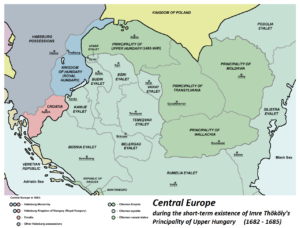
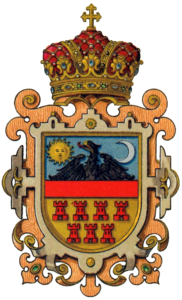

November 13, 1681: Thököly and Emperor Leopold I signed a truce









On November 19, the envoys of the new prince concluded an armistice in Vienna, which strengthened the Kuruc forces in the possession of the territories up to the Garam, but the imperial guards remained in some smaller fortresses. The mining towns were returned to Vienna, but Lipót had to hand over 3,000 forints of its annual income of 50,000 forints. Thököly again took on the role of mediator between Vienna and the Porte.

The fatal year 1683
On January 11, 1683, a Diet convened by Thököly began in Kassa, which was remarkably well attended (20 counties, 9 free royal cities, 3 bishops, 2 chapters, 1 monastery, 19 overlords, as well as observers from Leopold and Ibrahim Pasha), despite the prohibition of the Palatine.

The November armistice was confirmed and it was decided to send an envoy to the Sublime Porta to fulfill Thököly’s promise to mediate. However, there was a dispute between the prince and the participants about the Athnáme (they demanded its presentation, which Thököly refused) – in the end, only 50,000 forints in taxes were voted.

At the end of the Diet, Thököly again made a peace offer to Leopold: he wanted to be accepted in the 13 counties occupied by the Kuruc forces and to receive the title of imperial prince and the title of “Lord of the Parts of Hungary” in exchange for supporting Leopold as king in the event of war. In the event of the extinction of the male branch of his family, his lands would have reverted to the Habsburgs – this time his offer was again rejected. As a result of this, he took part in the 1683 campaign against Vienna on the Turkish side.
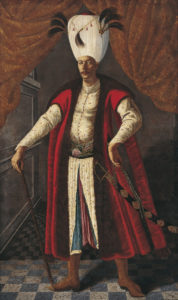
On April 1, the Turkish campaign against Vienna started from Drinapolis. On June 21, Thököly canceled the armistice with Vienna and then visited the camp of the Grand Vizier in Eszék, where it was agreed that the Turks would not raid the estates of those who had become loyal to the prince. As a result, the vast majority of the lords defected and supported the Turks with food and weapons.

Thököly then marched northwest along the left bank of the Danube, while his commissioners made the Trans-Danubian counties swear allegiance to him. In July, Nagyszombat and Pozsony (Pressburg, Bratislava) opened their gates to him. On August 29, Charles of Lorraine, commander-in-chief of the Imperial Army, expelled the Kuruc soldiers. On August 26, at Angern, near the Morava River, the Kuruc suffered a major defeat at the hands of the Polish troops marching towards Vienna.
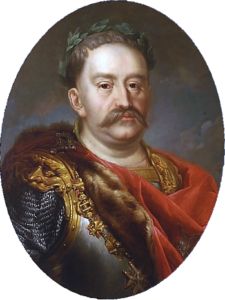
The next day, Thököly refused the Grand Vizier’s order to march on Vienna. This decision was probably motivated by several considerations: His good relations with the Polish King John Sobieski might have been a moderating influence, he did not want to leave Upper Hungary unprotected, and he reckoned that in the event of a Turkish victory, the Turks might soon withdraw from Vienna, as they had done after the ten-day sack of Buda in 1526.

On September 4, before Kara Mustafa’s disastrous defeat at Kahlenberg, he made his third peace offer to Vienna: in exchange for Bratislava and the mining towns, he offered to take 25,000 troops and turn against the Turks. Charles of Lorraine supported the offer, but the Court War Council (whose leader was a rival of the commander-in-chief) rejected it.

After the defeat of the army besieging Vienna, Thököly retreated eastward, again refusing the Grand Vizier’s orders to join the army – he did not take part in the Battle of Párkány on October 9, further worsening his relations with the Turks. During his retreat, Sobieski captured important areas of northern Hungary for Leopold. Prince Thököly continued to seek a special peace with Emperor Leopold through King Sobieski, but it was refused – the monarch demanded the conquest of Thököly and his retirement to private life.

In 1684, the Emperor proclaimed a general amnesty for the Hungarians, which was accepted by many, but not by Thököly. In response, Thököly issued a manifesto addressed to the Christian world and the Hungarians. “In defense of Christian religions and for the freedom of nations”. The manifesto pointed out the serial abuses of power and emphasized that the main goal of the Kuruc movement was to restore the rule of law and guarantee religious freedom. It referred to the old laws of the country and the coronation charters adopted by recent rulers.
15 October 1685 Thököly Imre was captured by the Pasha of Várad
As we have seen, the siege of Vienna was only possible because of Thököly’s success. Remember that Thököly did not give any troops to the Turks for the siege and even wanted to negotiate with the Habsburg leadership until the last moment, offering 25,000 troops to defend Vienna if they recognized his rule over the Highlands. When this did not happen, he watched the battle from afar.

He probably expected the Turks to take Vienna and either retreat (as they did when they took Buda in 1526) or leave a garrison in the shattered city. In this case, it is likely that Thököly could have easily driven the Turks out and strengthened his position for the conquest of Hungary. But Sobieski and the Winged Hussars arrived…

And the Habsburgs had learned their lesson: the next year the Turks might attack again, even with Thököly, and the Polish king might not always have help at his disposal… The question was, who would get their hands on Hungary: the Habsburgs or Thököly? They had no choice, they had to drive the Turks out of Hungary now or never. In doing so, they could lure the many soldiers of Thököly, who had no idea that the Turks would be driven out of the country for the Habsburgs’ benefit.
Remember that in 1664 the Habsburgs sabotaged the liberation of Hungary because Zrínyi Miklós (Nikola Zrinski) could have done it mainly by relying on the Germans and the French. It was not a dynastic interest. After the death of Zrínyi Miklós in 1664, the Wesselényi conspiracy was severely suppressed by the Habsburgs. The Habsburg Emperor seized the opportunity to deprive the richer Hungarian nobles of their wealth, regardless of their involvement in the conspiracy. No wonder so many people, including Thököly Imre, turned against the Habsburgs and rebelled against them in the following period. You can read more about this here:

Vienna did not fall, however, and the Sublime Porte blamed Thököly for the defeats. From then on, his power began to decline, and the imperial forces, in the course of the elimination of the Turkish occupation, slowly conquered his principality. In 1685 the Turks were driven back more and more from our country. Szolnok and Érsekújvár fell, and they suffered heavy defeats at Tát. They also liberated the fortresses of Vác, Arad, Heves and Törökszentmiklós. Read more about the Battle of Tát:
https://www.hungarianottomanwars.com/1541-1699/the-battle-of-tat-16-august-1685/

While the main army pushed from the Highlands into the center of the Plain, General Schultz’s army in Upper Hungary was tasked with destroying Imre Thököly’s Kuruc Principality. Schultz soon counterattacked. He managed to take Késmárk and Ung, among other places, but by September the balance of power had shifted to the Imperial Army.

Meanwhile, on August 30, Ibrahim Sejtán Pasha of Buda visited the successfully advancing Prince Charles of Lotharingia in his camp at Nagymaros. He offered to hand over Thököly and his “traitorous companions” to King Leopold in exchange for peace. Soon Schultz was advancing relentlessly into the territory of the Thököly principality. On September 13, he took Eperjes, and on September 29, he took Tokaj and with it the Tisza River region. Thököly retreated to the castle of Regéc, but the city itself was not taken by the Imperials after 21 days of siege. Ónod, Kisvárda, Szerencs and Kálló surrendered.

In February 1685, the Transylvanian Diet of Fogaras filed a suit against Thököly for treason, as a result of which his estates were confiscated. In May, the imperial troops besieged Ungvár for three weeks but finally retreated from the fortress without success. On September 11, Eperjes was conquered after a two-month siege.
The decline of Thököly’s power
The principality, called Orta-Madzsar (Central Hungary) in Turkish, collapsed when the Pasha of Buda ordered the Pasha of Várad, Ali, to imprison Thököly Imre, who had gone to Várad to ask for help, on October 15, as we had mentioned it before.

The story goes that he invited the prince to lunch, and the prince was reluctant to go, but he couldn’t say no. So after lunch, he wanted to leave quickly, but then the gatekeeper said, “No, sir, there is some black soup left,” i.e., coffee. This was the signal for the guards to burst in and arrest the “Kuruc King”.

So the Turks dropped the unnecessary Thököly and wanted to buy peace from the emperor by serving him. By this time, however, Leopold’s goal was no longer peace but the expulsion of the Turks, and so he did not ask for the Pasha’s peace offer. Ali and Ibrahim could hardly have done the Habsburgs a greater service than putting Thököly in chains. When they heard the news, the castles of Upper Hungary surrendered one after the other and the Kuruc troops turned to the side of the Emperor.

By November, 17,000 former rebels were in the service of the Habsburgs. According to a German officer, “The armed Hungarian troops are coming over to us in such large numbers that the army of Thököly’s converts, which has already grown to 12,000, is more trouble to us than if they were our enemies. Kassa, Patak, Regéc, Szádvár, and Ungvár opened their gates to the armies of Field Marshal Aeneas Caprara, who had taken over from Schultz. In the first week of November, only the castle of Munkács, held by Zrínyi Ilona, the wife of Thököly, was defended against the imperial army.

When Thököly was released from prison in Belgrade on December 20 and regained his title of prince, he had nothing left to rule. He marched in a solemn ceremony to Várad, the place of his humiliation three months earlier. Then, he continued to fight in the service of the Turks with his few thousand remaining followers, and he maintained contact with Zrínyi Ilona, but he was hardly counted on. Unfortunately, he failed to get Turkish auxiliaries to relieve Munkács, and when he retired to his estate in Hunyad County to raise an army, he was expelled by the order of Teleki Mihály.

In February 1687, on the order of the Grand Vizier, Thököly went to Várad to ask the local pasha for help in relieving Munkács. However, the pasha was unable to help, so Thököly had to return to Gyula with his work unfinished. In July he was given the task of guarding the Pétervárad bridge, which he did during the battle of Nagyharsány on August 12. He had to flee when a military mutiny broke out in the Turkish camp in September. He returned to the Várad area in October but did not manage to reach Munkács. You can read more about the heroic defense of Munkács here:
https://www.hungarianottomanwars.com/1541-1699/17-january-1688-the-fall-of-munkacs-castle/

On January 24, 1688, Klobusiczky Ferenc, the vice comes of Zemplén, presented the princely insignia of Thököly to Leopold in Pozsony. In February, the imperial general Donatus Heißler defeated Thököly’s small army at Telegd and then at Várad, which fled to Belgrade. After the imperialists occupied the city on September 6, Thököly participated in the suppression of a small anti-Turkish Bulgarian uprising. In the summer of 1689, Thököly occupied Orsova and then Újpalánk with an 8,000-strong Kuruc-Romanian-Turkish army. Due to his success, Margrave Louis of Baden, at the head of the imperial army, marched against him and drove him back to Moldavia.

Thököly, Prince of Transylvania
For a short time, in 1690, his lucky star seemed to shine again when the Sultan appointed him Prince of Transylvania, as the son of the deceased Prince Apafi Mihály was still a minor. Although Suleiman recognized the five-year-old prince in 1681, he did not renew this athnáme due to the older Apafi’s forced orientation towards Vienna.

Against him, the Transylvanian armies of Teleki Mihály and the Imperial armies of General Heißler defended Transylvania: they closed the passes and then encamped at Zernyest. Thököly, with his 15,000 Kuruc-Romanian-Turkish-Crimean Tatar army, mostly cavalry, crossed the impassable snows and attacked the rear on August 21, defeating the Transylvanian imperial forces in the Battle of Zernyest. Teleki died in the battle. Heißler was captured; in January 1692, Thököly exchanged him for Zrínyi Ilona, who had been under house arrest since January 1688, and told Leopold through her that he was ready to join the anti-Turkish struggles if he received the title of imperial duke. You can read the details of the Battle of Zernyest here:
https://www.hungarianottomanwars.com/1541-1699/the-battle-of-zernyest-thokolys-victory-1690/

On September 22, the representatives of the three Transylvanian nations (Hungarians, Székelys, Saxons) elected Count Thököly Imre of Késmárk as the Prince of Transylvania at the Diet of Kereszténysziget. The decision ordered the return of his property and made his Kuruc soldiers “national”.

After that, Count Louis of Baden with his sixteen cavalry regiments marched from Belgrade to Transylvania, from where he drove Thököly to Wallachia at the end of October and also blocked the road to Upper Hungary. (At the same time, Louis of Baden left Belgrade to its fate, which was occupied by the Turkish Grand Vizier on October 8). This incident was the moment when, as a result of the temporary crisis, Bethlen Miklós managed to sign the Diploma Leopoldinum with Emperor Leopold.

The fate of Thököly proves that the new pro-Turkish orientation that emerged among the Hungarians in the second half of the 17th century, which imagined the royal part of the country as a vassal state similar to Transylvania, is not viable at all. Moreover, the Sublime Porta was not afraid to abandon its vassals if it meant a better bargaining position. The Turkish orientation proved to be a dead end.
Thököly in Turkey

After that, Thököly and his handful of followers, who spread over the territory of the Turkish Empire, played an increasingly insignificant role in the history of Hungary. The Habsburgs took control and gradually drove the Turks out of the country. The Sublime Porte was no longer able to support him, although the French were still interested in him, especially after resumed his war against the Habsburgs in 1688. However, Thököly was isolated in terms of foreign policy.












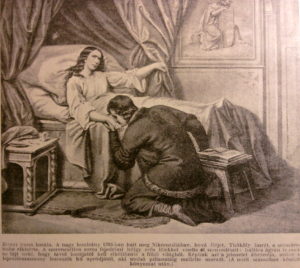



Dear Readers, I can only make this content available through small donations or by selling my books or T-shirts.
If you like my writings, please feel free to support me with a coffee here:
You can check out my books on Amazon or Draft2Digital, they are available in hardcover, paperback, or ebook:
https://www.amazon.com/dp/198020490X
or at https://books2read.com/b/boYd81


My work can also be followed and supported on Patreon:

You can find it here:
https://hungarianottomanwars.myspreadshop.com/all


